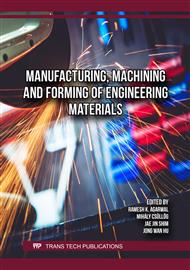[1]
Liu, J., Su, C., Chen, Y., Tian, S., Lu, C., Huang, W., & Lv, Q. (2022). Current Understanding of the Applications of Photocrosslinked Hydrogels in Biomedical Engineering. Gels, 8(4), 216
DOI: 10.3390/gels8040216
Google Scholar
[2]
Tilwani, R. C., de Yro, P. A. N., & Nakano, H. (2024). Comparative Examination of Cellulose Nanosphere from Corn Husk and Rice Straw. Materials Science Forum, 1115, 73–80
DOI: 10.4028/p-btm3ib
Google Scholar
[3]
Kailasa, S. K., Joshi, D. J., Kateshiya, M. R., Koduru, J. R., & Malek, N. I. (2022). Review on the biomedical and sensing applications of nanomaterial-incorporated hydrogels. Materials Today Chemistry, 23, 100746
DOI: 10.1016/j.mtchem.2021.100746
Google Scholar
[4]
Kass, L. E., & Nguyen, J. (2021). Nanocarrier‐hydrogel composite delivery systems for precision drug release. Wiley Interdisciplinary Reviews Nanomedicine and Nanobiotechnology, 14(2)
DOI: 10.1002/wnan.1756
Google Scholar
[5]
Tilwani, R. C., Calimon, K. N. A. K., & de Yro, P. A. N. (2024). Isolation of Cellulose Nanosphere from Corn Husk as a Filler for UV-Cured PEGDMA Nanocomposite Hydrogels. In Key Engineering Materials (Vol. 977, p.147–153). Trans Tech Publications, Ltd
DOI: 10.4028/p-a2llpb
Google Scholar
[6]
Karakurt I., Aydogdu A., Cikrikci, S., Orozco, J., & Lin, L. (2020). Strereolithography (SLA) 3D printing of ascorbic acid loaded hydrogels: A controlled release study. International Journal of Pharmaceutics, 584 119428.
DOI: 10.1016/j.ijpharm.2020.119428
Google Scholar
[7]
Sahoo, S., Barik, S., Dehury G., Dhala, S., Kanungo, S., Barik, B., & Puhan K. (2010). Evaluation of controlled release Theophylline microspheres prepared with cellulose acetate using solvent evaporation method. Tropical Journal of Pharmaceutical Research, 10 (2), 195-201
DOI: 10.4314/tjpr.v10i2.66563
Google Scholar
[8]
Ejikeme, P. M. (2007). Investigation of the physicochemical properties of microcrystalline cellulose from agricultural wastes I: orange mesocarp. Cellulose, 15(1), 141–147
DOI: 10.1007/s10570-007-9147-7
Google Scholar
[9]
Deguchi, S., Tsujii, K., & Horikoshi, K. (2006). Cooking cellulose in hot and compressed water. Chemical Communications, 31, 3293
DOI: 10.1039/b605812d
Google Scholar
[10]
Fredenberg, S., Wahlgren, M., Reslow, M., & Axelsson, A. (2011). The mechanisms of drug release in poly(lactic co-glycolic acid)- Based drug delivery systems - A review. International Journal of Pharmaceutics, 34-52.
DOI: 10.1016/j.ijpharm.2011.05.049
Google Scholar
[11]
Versipt, A., Pack, D., Braatz, R. (2013). Mathematical modeling of drug delivery from autocatalitically degradable PLGA microspheres- A review. Journal of Controlled Release, 165, 29-37
DOI: 10.1016/j.jconrel.2012.10.015
Google Scholar


